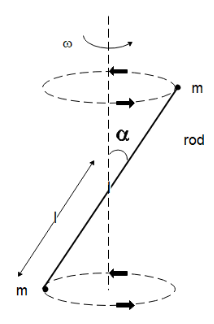
A massless rod $ S $ having length $ 2l $ has point masses attached to its two each as shown in the figure. The rod is rotating about an axis passing through its centre and making an angle $ \alpha $ with the axis. The magnitude of the rate of change of momentum of rod i.e. $ \left| {\dfrac{{dL}}{{dt}}} \right| $ equals

A) $ 2m{l^3}{\omega ^2}\sin \alpha .\cos \alpha $
B) $ m{l^2}{\omega ^2}\sin 2\alpha $
C) $ m{l^2}\sin 2\alpha $
D) $ {m^{1/2}}{l^{1/2}}\omega \sin \alpha .\cos \alpha $

Answer
554.7k+ views
Hint : In this solution, we will first determine the radius of the circle traced by the ends of the rod. Then we will use the formula for angular momentum to determine the change of angular momentum.
Formula used: In this solution, we will use the following formula:
Angular momentum of a rotating body: $ \vec L = \vec r \times m\vec v $ where $ \vec r $ is the radius, $ m $ is the mass, and $ \vec v $ is the velocity vector.
Complete step by step answer
We’ve been given that a massless rod with two masses attached to its ends rotates about its centre. Let us start with the radius of the circle traced by the masses at the ends of the rod. The radius of the circle will be equal to the perpendicular component of the length of the rod which will be determined as,
$ \sin \alpha = \dfrac{r}{l} $
$ \Rightarrow r = l\sin \alpha $
Then the angular momentum will be
$ \vec L = \vec r \times m\vec v $ . Since the velocity vector and the radius vector will be perpendicular in this case, the angular momentum will simplify to
$ \vec L = m\omega {r^2} $ $ (\because v = \omega r) $
As $ r = l\sin \alpha $ , the angular momentum will be
$ L = m\omega {l^2}{\sin ^2}\alpha $
Then the rate of angular momentum with respect to time
$ \left| {\dfrac{{dL}}{{dt}}} \right| = m\omega {l^2}(2\sin \alpha )\cos \alpha \dfrac{{d\alpha }}{{dt}} $
Since $ (2\sin \alpha )\cos \alpha = \sin 2\alpha $ and $ \dfrac{{d\alpha }}{{dt}} = \omega $ , we have
$ \left| {\dfrac{{dL}}{{dt}}} \right| = m{l^2}{\omega ^2}\sin 2\alpha $ which corresponds to option (B).
Note
Here since the rod is massless, we can directly treat the point masses at the end of the rods directly without any influence of the rod on the dynamics of the situation. Since we only want to find the magnitude of momentum, we don’t have to worry about the direction of the angular momentum of the rod system.
Formula used: In this solution, we will use the following formula:
Angular momentum of a rotating body: $ \vec L = \vec r \times m\vec v $ where $ \vec r $ is the radius, $ m $ is the mass, and $ \vec v $ is the velocity vector.
Complete step by step answer
We’ve been given that a massless rod with two masses attached to its ends rotates about its centre. Let us start with the radius of the circle traced by the masses at the ends of the rod. The radius of the circle will be equal to the perpendicular component of the length of the rod which will be determined as,
$ \sin \alpha = \dfrac{r}{l} $
$ \Rightarrow r = l\sin \alpha $
Then the angular momentum will be
$ \vec L = \vec r \times m\vec v $ . Since the velocity vector and the radius vector will be perpendicular in this case, the angular momentum will simplify to
$ \vec L = m\omega {r^2} $ $ (\because v = \omega r) $
As $ r = l\sin \alpha $ , the angular momentum will be
$ L = m\omega {l^2}{\sin ^2}\alpha $
Then the rate of angular momentum with respect to time
$ \left| {\dfrac{{dL}}{{dt}}} \right| = m\omega {l^2}(2\sin \alpha )\cos \alpha \dfrac{{d\alpha }}{{dt}} $
Since $ (2\sin \alpha )\cos \alpha = \sin 2\alpha $ and $ \dfrac{{d\alpha }}{{dt}} = \omega $ , we have
$ \left| {\dfrac{{dL}}{{dt}}} \right| = m{l^2}{\omega ^2}\sin 2\alpha $ which corresponds to option (B).
Note
Here since the rod is massless, we can directly treat the point masses at the end of the rods directly without any influence of the rod on the dynamics of the situation. Since we only want to find the magnitude of momentum, we don’t have to worry about the direction of the angular momentum of the rod system.
Recently Updated Pages
Why are manures considered better than fertilizers class 11 biology CBSE

Find the coordinates of the midpoint of the line segment class 11 maths CBSE

Distinguish between static friction limiting friction class 11 physics CBSE

The Chairman of the constituent Assembly was A Jawaharlal class 11 social science CBSE

The first National Commission on Labour NCL submitted class 11 social science CBSE

Number of all subshell of n + l 7 is A 4 B 5 C 6 D class 11 chemistry CBSE

Trending doubts
Differentiate between an exothermic and an endothermic class 11 chemistry CBSE

10 examples of friction in our daily life

One Metric ton is equal to kg A 10000 B 1000 C 100 class 11 physics CBSE

Difference Between Prokaryotic Cells and Eukaryotic Cells

1 Quintal is equal to a 110 kg b 10 kg c 100kg d 1000 class 11 physics CBSE

State the laws of reflection of light




